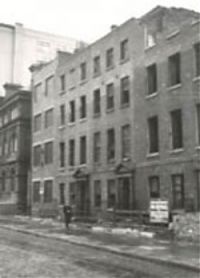The Prescot Street Old Infirmary
The Prescot Street area, lying just outside the City of London’s boundaries, was considered to have a very bad reputation by the late Georgian period. It had a number of brothels, disorderly taverns and theatres, such as the notorious Goodman’s Fields Theatre (opened in 1703), many of which had been forced out of the City of London by the authorities.
The London Infirmary, as it was then known, moved to Prescot Street, Goodman’s Fields, in May 1741 from its premises in Featherstone Street, Moorfields.
The London Infirmary aimed to treat ‘sick and diseased manufacturers, seamen in the merchant service and their wives and families’. Another house next door was added, known as ‘the Lock’. This was originally intended for the benefit of patients suffering from sexually-transmitted diseases, who were expected to pay for their treatment. But, within a few years, it offered free treatment and no longer specialised in venereal diseases. The hospital was dirty and unhygienic. Professional pest controllers deloused the wards regularly. There was no running water, and human excrement, dirty dressings and amputated limbs were removed at night by orderlies and dumped in the street outside.
Sanitation in Prescot Street in the 1740s and 1750s was rudimentary at best. The hospital committee noted that it was expensive to have their cesspool emptied regularly, so opted instead to let effluent overflow into a common cesspool via a neighbour’s garden. A mortuary was built in the gardens behind the Prescot Street houses, and a post-mortem room erected above it. A herb garret was also erected for drying and storing medicinal herbs. The hospital’s first physician, Dr John Andree was an exponent of the therapeutic value of cold bathing, so a cold-water bath was also built in the Prescot Street gardens for the benefit of patients. By 1746, the five houses in Prescot Street were already in a state of disrepair, and were let to the Magdalen Hospital.
Adapted from an article written by St Bartholomew’s and The Royal London Hospitals Museums
- Author: Lorna Richardson |
- Apr 01, 2008
- Share
